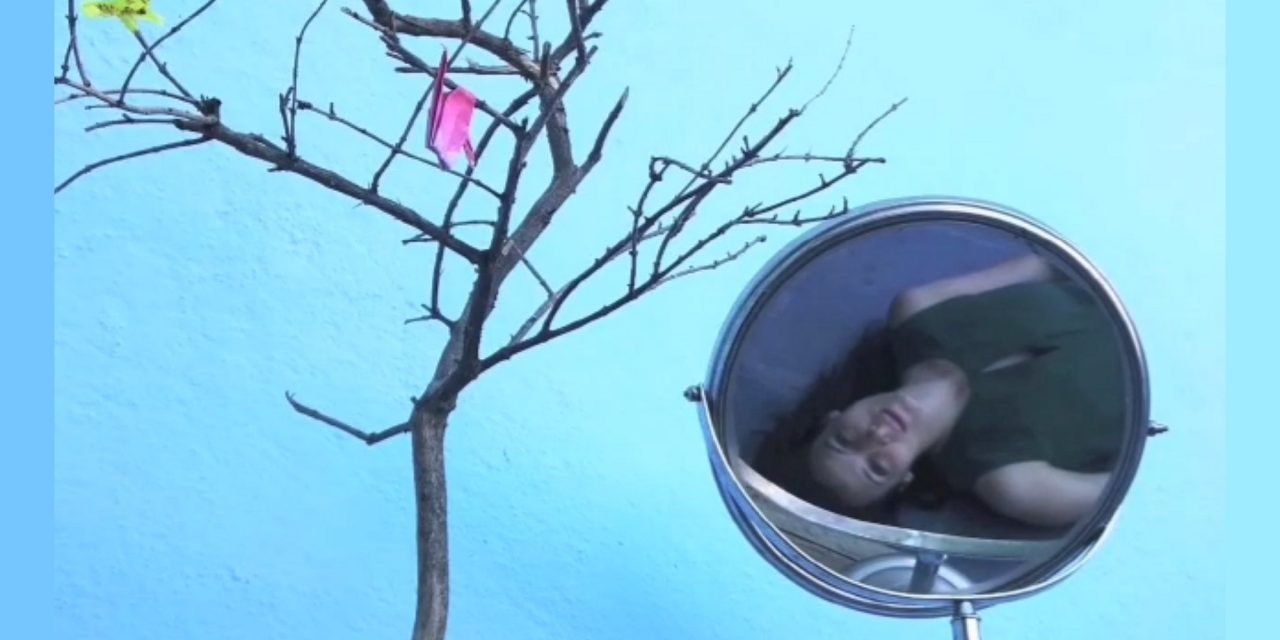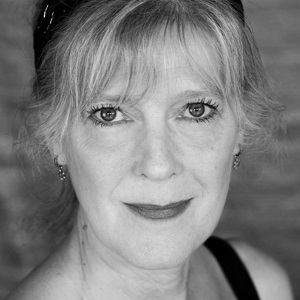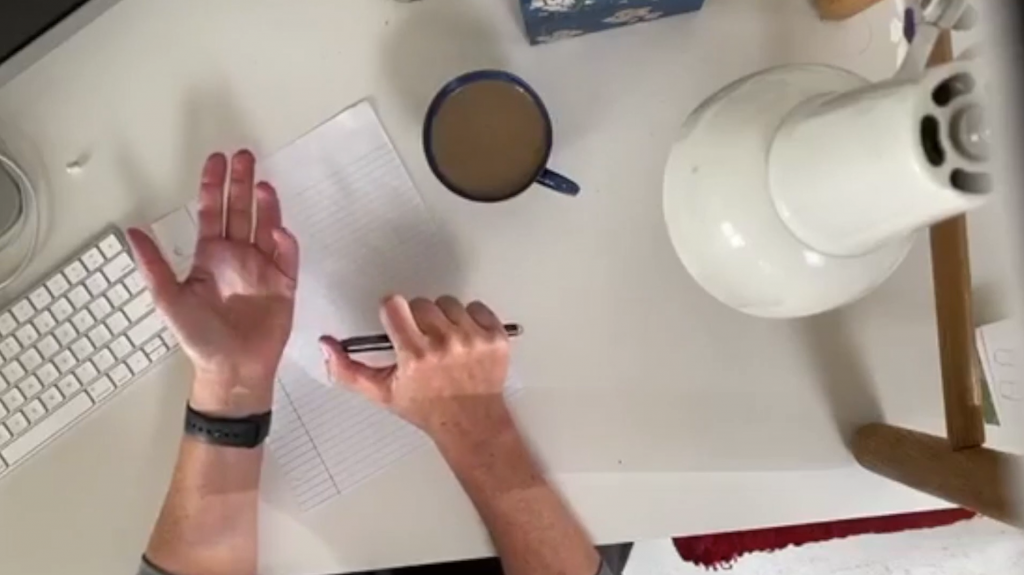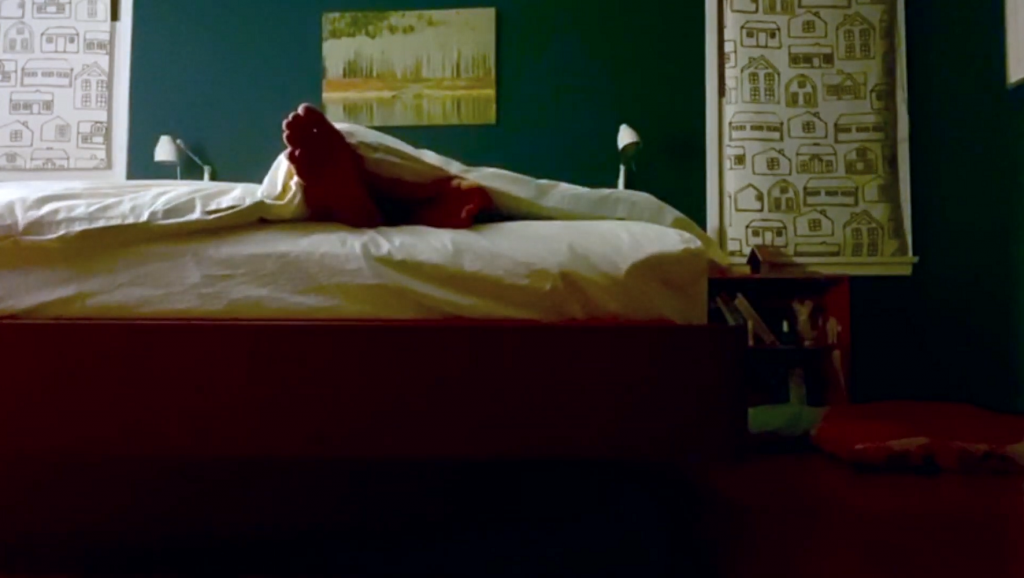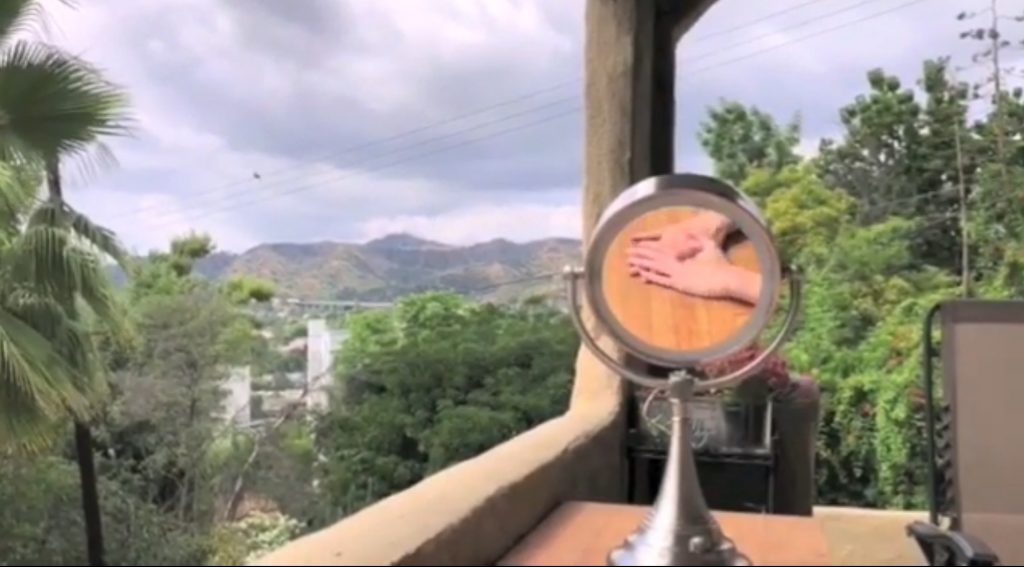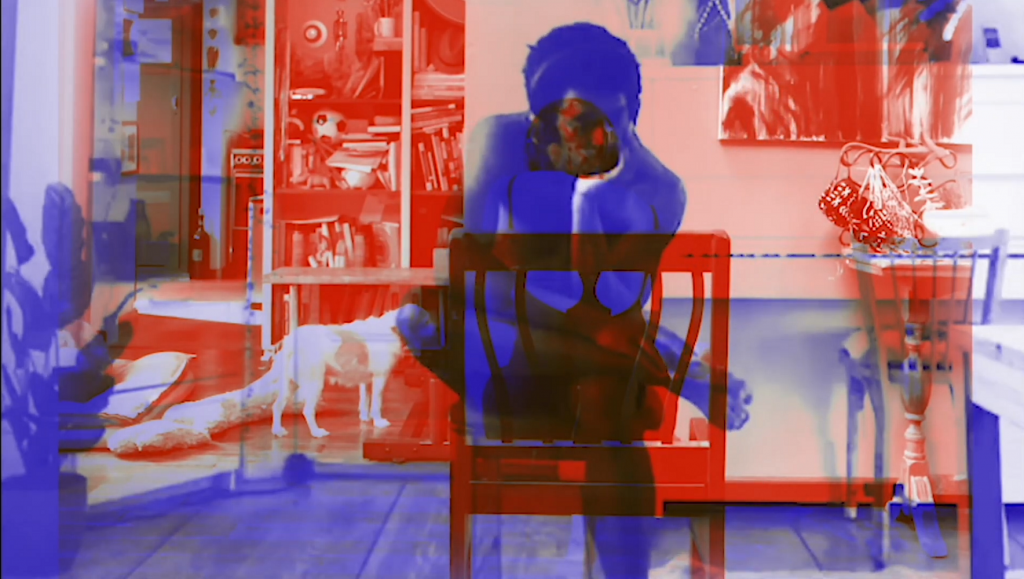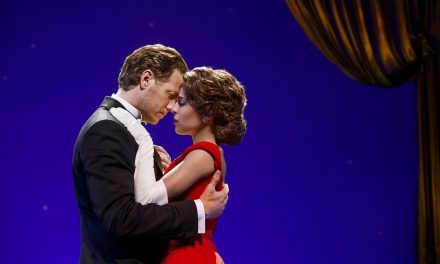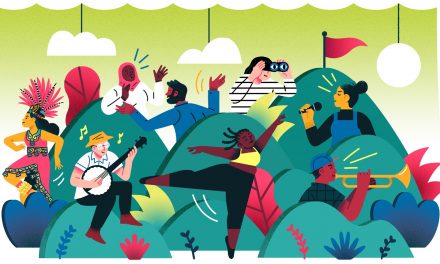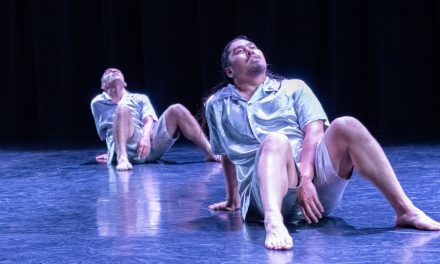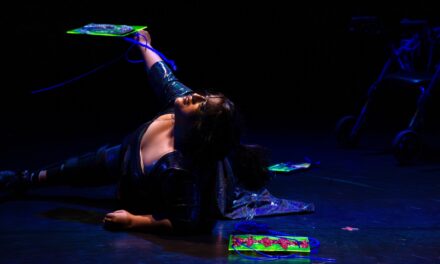“We share space, breath, movement and emotion. We collaborate in real time whether it’s to create something new or to perform something familiar. In this time of social distance can we create that kind of connection from behind a screen? We share our online selves with people all over the world via social media, but is that “connection” authentic? Is it personal?”
The above is a statement that accompanied the Nancy Evan Dance Theatre’s (NEDT) announcement of The Channels Project, a series of short videos produced by 12 dancers working remotely from 3 continents during these unparalleled times of Covid-19. There are three videos currently available for viewing: Parallel by Jenn Logan and Marcos Novais, Connections by Karina Francis Jones and Ricard Campos Freire, and Behind the Mirror by Jen Hunter and Irupé Sarmiento (see link below). After viewing and knowing that this was the company’s inaugural expedition into film/video, I was impressed by their production qualities and professionalism; enough so to email a list of questions to Artistic Director Nancy Evans Doede to learn more.
My first question to Doede was to explain the genesis of The Channels Project.
“The pandemic forced my perspective, since normal routines were disrupted and I was having to acclimate to the online platform for all of my teaching, our Company class, and any future rehearsals,” Doede wrote. “In the isolation, I started to wonder: What is a global community? Yes, we were all experiencing a common thread – COVID-19, but did we really have a sense of community as individuals around the globe? If you or someone you know has suffered from the virus, then I think that thread is evident in that there is a stream of compassion and mutual grief, and that can be communal, without actually knowing the other people personally. With everything “on hold” globally, I decided to investigate the question more.”
Doede explained how she wanted to create a “microcosm within the dance world” as well as provide a creative outlet for her company members. “To me, real community involves getting to know someone else, finding common threads between you, and developing a relationship that begins to include others that you know.” She said, and therefore set about matching up dancers in her company with dancers she knew in other parts of the world.
“I had six people in mind to match with my six dancers. I spoke with my son, Nik, who dances with Ballett Augsburg in Germany, and asked him what he thought of the idea of creating duets with the six dancers we mutually know from Europe, Asia, and South America. We had a couple of great brainstorming sessions before I presented the idea to my company or the other dancers. The working title in my mind was “Channels”, and that title played on two levels.” Doede continued. One of those levels was, of course, the channels on a television set that we are all accustomed to flipping from one T.V. Station to the next. The second image of the word channel for Doede was the idea of the numerous channels of water that feed into a river. NEDT settled on six channels to begin with, leaving it open for expansion.
“In one life, there are many people who flow in and out of it and affect and effect that life as part of becoming who that individual is or is meant to be,” Doede said. For me, this is a path to creating community globally.” With this in mind, she asked each dancer to take the risk of working with someone else that they did not know, ask questions, explore ideas and to create a short work based on this exploration.
A few of the dancers in Europe were currently under contract with professional companies, so there could not be any compensation offered. They agreed to work on a totally volunteer basis, and most of those involved worked primarily with video.
“I set up a text group on WhatsApp, and that became our stream for information,” Doede explained. “We had an initial meeting where I described the project and then asked them for their responses and ideas. I matched up the dancers based on knowing their personalities, and similarities in movement quality.”
As it worked out, three of the duets were comprised of people who had not previously met; two were made up of dancers who had worked with Doede’s son Nik in a piece titled Episode 8; and her son Nik paired up with his sister Ashleigh, who is a NEDT member, for the final duet. These siblings had grown up in a dancing family, training at the same studio, and each had performed in Doede’s choreography.
“At that initial meeting – with time differences between 5 and 9 hours, I gave them the background of the project’s concept, and then said that I wanted them to explore questions – simple questions, in order to get to know one another,” Doede wrote. Each couple would be recording their content, edit it, score it with original sound or music to avoid any copyright issues.
Doede left it open as to whether or not the artists used dance vocabulary, but she did set deadlines on when the videos would be completed, leaving time for clips to be submitted, feedback given and, if necessary, changes to be implemented. “Along the way, they sent clips of what they were working on, and we gathered together every few weeks to discuss progress, look at and make observations on clips presented, and get to know one another better through sharing that time and the progressive work,” She said. “From those conversations, we decided to launch three of the six channels at once, and the other three shortly thereafter.”
When asked if the company would continue this project, Doede said that for now there are only these six dancers working on six works, but if they chose to switch up the duets to create more, that she would definitely support them. “They can always reboot later. It’s a project that could easily filter into the greater dance community, and I would be happy to foster that collaboration. “ She added. “In my dreamscape, I’d love to see this idea continue to create more channels down the river. I’d love to curate this project with more dancers. It’s not enough to just make a film. The collaborative process between the dancers is, of course, critical. However, the interaction between all of the participants through the meetings and presentation of ideas is the heart of it.”
During this process Doede discovered that many of the dancers who have been hired to work outside the US seldomly get the opportunity to create their own work. It is not just a scheduling issue, but one of lack of constructive creative feedback from other professional dancemakers. “To be a part of this process was, as they put it to me, a gift,” She said. “Their collective humility and enthusiasm was profound, to me. All of these dancers are remarkable human beings, with talents that include, but go far beyond their dancing. It was an honor to work with them all.”
My last question to anyone I interview is if they have anything to share that was not covered during the interview – in this case the email. Their responses are always informative and in many cases, inspirational. Doede’s answer was no exception.
“As I continue down the path towards artistry, I believe it is my responsibility to help foster creative expression. As my performing self becomes less visible, my energy is going toward encouraging the artistry in younger generations. I look for those who are willing to explore, who are open-hearted and committed to helping to make the world a better place – as people. That they are also devoted to the Arts completes the circle. The Channels Project is a first glimpse into what some of these artists have to offer. There is a wealth of possibility in these short forays into human connection beyond contact. Most dance artists I know are adept at more than one facet of the Arts. Yes, they share dance as their point of connection. But within these 12 dancers there are musicians, artists, composers, photographers, bakers, aerialists, seamstresses, nurses, teachers, choreographers, designers, and writers. So much to share. So much to learn from one another.”
I was thrilled when Doede informed me that she took it upon herself to include the dancers by asking them three questions. 1. What was the process in deciding what you wanted to portray? 2. How did your collaboration evolve? And 3. What were the challenges.
The Dancers Speak for themselves:
PARALLEL: Jenn Logan and Marcos Novais (Jenn NEDT/USA, Marcos is from Brazil, working in Wiesbaden, Germany)
Marcos WHAT WAS THE PROCESS IN DECIDING WHAT YOU WANTED TO PORTRAY?
Create this video together with Jenn was a challenge as creating a choreography. In mind everything seems to be easy and possible, but to find a way how to make all our ideas and thoughts come visibly true together is not so easy as it seems. Jenn had most of the hardest job. We first met in a zoom meeting to get to introduce and know each other (as we have never seen each [other] before), and finally talk about ideas. I came up with the TIME IDEA. Between Germany and L.A at that time we were around 10h in difference. With this huge time gap, when I was waking up, she might be going to sleep, when I was having my dinner she would be on a breakfast time and etc. she really liked the first idea and during the process we found that the story needed feelings and more connection between us; and we decided to find a new way where either being in different time we could still be together as we were leaving in the same house, sharing the same bed, the same routines, and even the shower but in different day time.
HOW DID YOUR COLLABORATION EVOLVE?
-I’ve came up with the first idea as explained before
– A friend of mine got to compose a music especially for this work.
And we’ve shared so many videos with different ideas to find the best ones to get the connection we were looking for.
(I tried to be as human as possible and create [a] scene where anyone could feel connected. As you could see there’s just one scene where we created moments. And the dogs were part of that scene also ❤️)
WHAT WERE THE CHALLENGES?
-The most challenge part for me was the timing difference. Where sometimes we were taking really long to get to reply [to] each other.
-The second one was about finding music rights. We have tried so many things but at the end most of our options were not rights free. Lucky I could connect with a friend of mine Javier Ara Sauco, whose has also created lots of beautiful music for the videos we had to develop with all the dancers at the dance company I work here in Wiesbaden. He was in holidays with his family at that time, but he proposed himself to hear about our idea and create a music inspired in what we were looking for. After a week he came up with 3 options and we choose the most beautiful one.
-for JENN it was so hard job to edit and make a way to our idea come true. I have no idea about video editing etc., and she’s expert on that [so] she took over the hardest job. I just recorded lots of options where she could get inspired and she also recorded herself in a way that for her would be right to edit after.
Jenn:
Process: Our concept came about pretty quickly. Marcos lives in Wiesbaden, Germany and I’m in Los Angeles so our days and nights were flipped. Just trying to organize our first Zoom call made it apparent how challenging our time difference would be, so we decided to embrace it. We wanted to explore common, everyday activities that could clearly represent times of the day. We gave each other locations to explore (all within our homes because at the time we were all under lockdown). Marcos filmed in 3 locations and I filmed a response. Then I filmed in 3 locations for him to respond to. If he shot in the morning, I shot at night. It was designed to work like a timeline, but instead of being completely linear—from left to right, our scenes meet in the middle. The scene on the chair is mid-day for both of us. What surprised me was how intimate it ended up being. You don’t generally share a bathroom with someone you hardly know, and yet…
Challenges: The time difference was tricky, and the fact that Germany opened back up well before LA did made our schedules very different. Our exchanges were never quick because I was probably sending notes in the middle of the night for Marcos, but we developed a system. It just meant that things took a little longer than they might have if we were in the same time zone.
Music: Knowing that the film would live online meant that we had to be sure our music rights were secure. We were extremely fortunate that Marcos was able to recruit a composer friend, Javier Ara Saurco, to collaborate. He was amazing to work with. We shared a few clips with him and discussed the tone we were going for. With just a little back and forth, he nailed it almost immediately.
Editing: I took that on because I wanted the challenge. It’s not something that I was terribly comfortable with prior to this project. Let’s just say I was thankful for the extra time the pandemic gave me to learn a new skill. It gave me time to experiment. I wanted to do more than splice together scenes. Exploring our contrast visually was an important part of the story. The contrasting orange and blue came about from a happy accident. One of the first scenes we shot was jumping on our beds. His sheets were all blue and mine were all orange…color story set.
All things said, it was a lot of work, but worth it. I loved working with Marcos and hope that someday we’ll get to work together in person, or just meet face-to-face.
*************************************************
CONNECTIONS: Karina Francis Jones and Ricardo Campos Freire (Karina NEDT/USA, Riki is from Portugal and lives in Germany, teaching/choreographing internationally)
Karina, with Riki’s input:
First off, we didn’t know each other at all and we are very different people. He’s a guy from Portugal engaged to be married and a frequent traveler for work/dance, I’m an older American woman with two kids who’s in the process of getting divorced and having to reimagine a whole new life. That being said, I think we’re very similar as well. Riki is extremely likable and sweet and it doesn’t take long to feel as though you’re good friends within one conversation. Hey, is very warm, welcoming and supportive, so working with him was so easy because of that. I would surely like to meet him someday.
Our process started first with us having a nice long chat on WhatsApp where we got to know each other a little bit. We then decided to start sending each other video snippets of our daily lives. I really don’t like my face on camera, so I started sending him clips of my feet walking throughout the day. We both ended up liking the idea of using our feet as a window into our daily lives. Riki suggested we start recording the sounds around us, and also trying to find sounds with a rhythm or cadence. As we started putting pieces together we realized that the cadence could show the rhythm of a day, and even more so apparently rhythmic and repetitive during the pandemic. Looking at our feet as they walked through our morning routine, or through the day, showed the similarities as well as the differences. It seemed we were showing the pace/heartbeat/cadence of our lives. Both of which were dealing with challenges that we were wrestling with. In the end we started fitting the pieces together like a puzzle. We broke the foot pattern a bit by introducing our faces and hands into the mix, like an introduction. Those pauses seemed to offer an opportunity for a new perspective or insight.
The challenges were mostly technical. Riki just had to deal with the technological issue of video files slowing his computer down. And then it was also a bit challenging to communicate how editing could be done with regards to minor changes and adjustments without being right there to work on it together, but we managed pretty well! I think it was important that we felt we could be open and honest with each other in how we felt certain edits felt. Whether we thought it worked or not. That can be hard when you work with someone new! But again, Riki is so easy to be open with and he’s super supportive and energetic. It was really a joy to work with him. I actually felt badly because I felt like he had a greater workload because of having to do all of the editing, but he made me feel like it was no big deal.
**********
BEHIND THE MIRROR: Jen Hunter and Irupe’ Sarmiento (Jen NEDT/USA, Irupe’ lives in Brazil and works as an independent dancer/teacher/choreographer)
Irupé:
1/ This idea from Nancy was amazing. Brought us a possibility of creation that I would never imagine. Somehow opened a new way of creation. With Jen was very easy to connect. After the first meeting we exchanged some voice messages introducing each one to the other and sharing not only how we got to the dance universe but also special things from us. I was in lockdown so the only place I could go to have air was the garden of my in law parent’s garden. And with Jen was similar. So, we started to show our gardens and to think of possible connection. Somehow the mirror came up bringing in us the connection we were looking for. So, we thought why not to connect each other throw the mirror, use it where the door to another world.
2/ I think the challenge in my case was more the editing part. Because I never did such a thing. So, at the beginning [it] was hard to understand the timing of the scenes and what we wanted to show. We had so many beautiful images and we didn’t want to stay tedious, so the selection was hard. But at the end we were very happy with the result!
Jen:
What was the process in deciding what you wanted to portray?
How did your collaboration evolve? (I feel like this answers the first 2 questions)
We spent a lot of time getting to know each other. We would text and send voice messages back and forth to each other. We talked about what the world was like where we lived. Irupé is in Brazil and the cases of COVID were very high where she was. She was staying in her backyard a lot, as was I (in LA). We started taking videos of our backyards and sharing it with each other. We liked the subtle differences of where we lived, but we also noticed it didn’t look so different after all. And then our movie evolved into us filming through a mirror, we both happened to have a mirror that looked similar. We would film everything through the mirror; trees, flowers, wind, hands, faces, everything. We did a lot of editing and ended up with “Behind the Mirror.”
What were the challenges?
I think before the project started the challenge was thinking about creating something with a person that lives so far away and that I have never met before. But it honestly worked out so much better than I expected. It ended up being fun to collaborate and get to know someone, and Nancy did such a good job with the pairing that it was never difficult to start creating the movie with Irupe’.
**********
ARE YOU: (not yet released) Ashleigh and Nikolaos Doede (Ashleigh NEDT/USA, Nik dancing in Ballet Augsburg in Germany)
Ashleigh:
So, Nik answered the question about editing – here’s our concept:
This project was super fun and interesting, especially as a brother/sister combo! As siblings, we have grown up together dancing alongside each other and together as partners and choreographers; however, we have never had the opportunity to actually collaborate on a project together. We started off just catching up on where we are in life as adults and being thousands of miles away which took us into discussing everything that’s been happening in the world. The topics of pandemic and the racial injustices going on brought us around to how we as a human race are talking but aren’t really listening to each other. This can even happen in our day to day conversations with people we know and love too. So, our concept was then birthed! Are we actually listening to each other?
The challenges were coordinating time to discuss the next steps and when it came time to edit! We were able to tape things on our own but to keep the ball rolling was hard really due to our time difference of 9 hours and life schedule. Despite all that, it was definitely doable and we have part two we are working on!
Nik:
Question 2: The evolution of our project started via zoom and talking about our idea together. We each filmed some clips separately and sent them to each other to get an idea of where we were headed. From there we kept sending video ideas until we got the clips we wanted to use and then from there I edited the clips together here in Germany. Then I sent that back to Ashleigh and we kept tweaking it that way until we were happy with it. It was definitely a challenge because we were not working in real time. We would have to wait sometimes a week or more to connect due to our schedules and the time difference. Though it was challenging, it was a unique way to work that was actually pretty fun and inspiring. The music I recorded at home. We wanted to use natural sounds, like whispering or the sound of water, and there is also some scratching sounds. We preferred a non-melodic soundtrack to better accompany our idea. Locations were just places around the house and using household items to film behind or in front of to add a natural distortion to our faces. It was really a fun challenge to see what we could use just around the house.
**********
NICE TO MEET YOU: (not yet released) Noel Dilworth and Jiwon Kim Doede (Noel NEDT/USA, Jiwon from South Korea, independent dancer/teacher in Augsburg, Germany)
Jiwon:
1. We decided to simply introduce ourselves to each other, because we really don’t know each other.
We decided to focus on different parts of our body rather than our faces to say hello, because there is more than one way to introduce yourself. Using different parts of our bodies we aimed to show more of our characters and personality.
2. We wanted to make sure to show the time difference between us. So, we filmed at opposite time of the day. We also wanted to put the natural sounds as music from each city to tell you where we are. I also asked my husband Nik to compose some minimal music to accentuate our movements.
3. It was a challenge to show our personality through our specific parts of the body. However, the reward at the end of this process was well worth the challenges that we faced. a series of short films produce
Noel: (Noel attached a Word doc, but Doede was unable to open it.)
**********
UNTITLED: (not yet released) Katrina Amerine and Shori Yamamoto (Katrina NEDT/USA, Shori is from Japan, dancing with Gautier Dance in Stuttgart, Germany)
Katrina:
What was the process in deciding what you wanted to portray?
My partner Shori and I chose to interact with an object. We chose different objects for different reasons. I think our project is unique in choosing to explore different feelings from each participant rather than focusing on what we share.
How did your collaboration evolve?
It is still evolving; we both have had a lot of changes in our lives this year. Every time I work on this project I have different energy and perspectives.
What were the challenges?
Realizing that this project was not just between my me and my partner. I needed a lot of help in person to get it done.
Thank you to Nancy Evans Doede and the dancers for taking time out of their busy lives to respond to this inquiry.
To watch the first in the series of short videos produced for The Channels Project, click HERE.
To visit the Nancy Evans Dance Theatre website, click HERE.
By Jeff Slayton for LA Dance Chronicle.
Featured image: Behind the Mirror by Jen Hunter and Irupe’ Sarmiento – Screenshot by LADC

